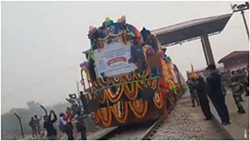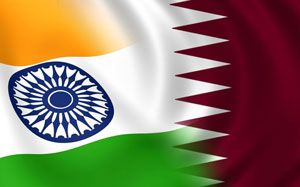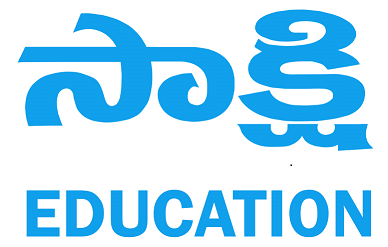December 2020 India and the World
Sakshi Education
- All about Haldibari-Chilahati Rail Link
 India and Bangladesh are set to reopen the Chilahati-Haldibari rail link after more than 5 decades to enhance the connectivity between the two countries.
India and Bangladesh are set to reopen the Chilahati-Haldibari rail link after more than 5 decades to enhance the connectivity between the two countries.
Chilahati-Haldibari link was cut off during the 1965 India-Pakistan war.
Haldibari in India and Chilahati in Bangladesh.
The Haldibari-Chilahati rail link was operational till 1965.
This was part of the broad-gauge main route from Kolkata to Siliguri during the partition.
Trains traveling to Assam and north Bengal continued to travel through the then East Pakistan territory even after partition. For example, a train from Sealdah to Siliguri used to enter East Pakistan territory from Darshana and exit using the Haldibari-Chilahati link.
However, the war of 1965 effectively cut off all the railway links between India and the then East Pakistan.
So, on the eastern sector of India, the partition of the railways thus happened in 1965.
With this link, tourists from Bangladesh will be able to visit places like Darjeeling, Sikkim, Dooars, apart from countries like Nepal and Bhutan.
Economic activities of these South Asian countries will also be benefitted from this new rail link
This rail link will enhance rail network accessibility to the main ports, dry ports and land borders to support the growth in regional trade and encourage economic and social development of the region.
- MoRTH signs MoU with Austria on Technology Cooperation in Road Infrastructure Sector
A Memorandum of Understanding was signed between India and Austria on Technology Cooperation in Road Infrastructure Sector in New Delhi.
The MoU seeks to create a framework for the countries’ mutual cooperation in the field of Road Transportation, Road/Highways infrastructure development, management and administration, road safety and intelligent transport systems.
This is to enhance trade and regional integration between the two countries.
Austria has the latest technologies for highways and roads such as intelligent transportation system, electronic toll system, traffic management system, landslide protection measures and tunnel monitoring systems.
The first two satellites of Austria namely UniBRITE and TUGSAT-1/BRITE were launched by the PSLV-C20 of India from the SatishDhawan Space Centre located in Sriharikota, India. The satellites were launched in 2013.
- India challenges Vodafone arbitration award, plans the same in Cairn case
The Indian government has lost another retrospective taxation case against Cairn Energy PLC, after Vodafone Group PLC.
The Permanent Court of Arbitration in The Hague unanimously ruled in favor of Cairn Energy stating that the Indian government failed to uphold its obligations under the India-UK bilateral investment treaty.
The Cairn Energy case dates back to 2006-2007 when as a part of the reorganisation, Cairn UK transferred shares of Cairn India Holdings to Cairn India.
The company faced a tax probe eight years after in 2014 after the IPO-related reorganisation.
The income tax department raised a demand of capital gains tax on Cairn UK amounting to $2.74 billion. The firm disputed the demand and the matter was heard by the I-T Appellate Tribunal and then the Delhi High Court.
Though Cairn lost the case at ITAT, a case on the valuation of capital gains is still pending before the High Court.
In 2011, Cairn Energy had sold majority of its India business, Cairn India, to Vedanta.
The income tax department, however, did not allow Cairn UK to sell 10 percent and attached Cairn India shares as well as dividends that the company paid to its parent.
The tax authorities had claimed to have identified unassessed taxable income resulting from the intra-group share transfers undertaken in 2006 in preparation for the IPO.
The notification referred to retrospective Indian tax legislation that was enacted in 2012, which the tax department had sought to apply to the 2006 transactions.
The center had taken action against Cairn Energy to recover the tax liability by selling the company’s 5 percent holding in Vedanta and seizing dividends worth Rs 1,140 due to it and setting off Rs 1,590 crore tax refund against the demand.
Cairn Energy claimed that it suffered a loss worth $1 billion for a transaction that had been approved by the Foreign Investment Promotion Board, which also had the revenue secretary as its member.
The center is currently studying the award and all its aspects in consultation with its counsel.
After these consultations, the government will consider all its options and take a decision on the further course of action, including legal remedies before appropriate forum.
In case the center fails to pay the amount, Cairn Energy PLC can approach courts in countries such as UK to seize any property owned by the Indian government to recover the money.
- India, Qatar to set up energy task force
 India and Qatar are to establish a task force on energy. The task force will be represented by a senior officer from petroleum Ministry of India and the vice president of Qatar petroleum.
India and Qatar are to establish a task force on energy. The task force will be represented by a senior officer from petroleum Ministry of India and the vice president of Qatar petroleum.
The task force is to identify projects in the Indian energy sector for Qatari investments. These announcements were made after the telephone conversation between Minister of Petroleum and Natural gas and steel Shri Dharmendra Pradhan and his Qatar counterpart.
Qatar holds around 1.5% of world oil reserves. It ranks 14th in terms of oil production in the world. The oil production of Qatar is 402 Times it’s oil consumption.
In September 2020, Qatar brought in new labour laws. These laws abolished the unjustified “Kafala System”. Under this system, the migrant workers had to get a no objection certificate from their employers before changing jobs. Also under the law the minimum wages was increased by 25%.
- UNESCO launches 2020 State of the Education Report for India: Vocational Education First
The ‘State of the Education Report for India 2020: Technical and Vocational Education and Training (TVET), was launched virtually by UNESCO New Delhi.
The strategy is in alignment with the Sustainable Development Goal and Education 2030 Framework for Action.
The second edition of the State of Education Report focuses on technical and vocational education and training (TVET).
Report aims to serve as a reference tool for enhancing and influencing the policies and programs related to skills development in India.
Recommendations
Place learners and their aspirations at the center of vocational education and training programmes
Create an appropriate ecosystem for teachers, trainers and assessors
Focus on upskilling, re-skilling and lifelong learning
Ensure inclusive access to TVET for women, differently abled and disadvantaged learners
Massively expand the digitalization of vocational education and training
Support local communities to generate livelihoods by engaging in the preservation of tangible and intangible cultural heritage
Align better with the 2030 Agenda for Sustainable Development
Deploy innovative models of financing TVET
Expand evidence-based research for better planning and monitoring
Establish a robust coordinating mechanism for inter-ministerial cooperation.
- What is India’s rank in Human Development Index? – GK > stock
India dropped two ranks in the United Nations’ Human Development Index this year, standing at 131 out of 189 countries.
The United Nations Development Programme (UNDP) for the first time, introduced a new metric to reflect the impact caused by each country’s per-capita carbon emissions and its material footprint, which measures the amount of fossil fuels, metals and other resources used to make the goods and services it consumes.
Norway topped the index, followed by Ireland and Switzerland. Hong Kong and Iceland complete the top five.
India, Bhutan, Bangladesh, Myanmar, Nepal, Cambodia, Kenya, and Pakistan were ranked under countries with medium human development with a rank in between 120 and 156 among the 189-counties.
In the BRICS grouping, Russia was 52 in the human development index, Brazil 84, and China 85.
India’s gross national income (GNI) per capita on the basis of purchasing power parity (PPP), too, fell from $6,829 in 2018 to $6,681 in 2019, it said.
India’s HDI value for 2019 is 0.645, which put the country in the medium human development category, positioning it at 131 out of 189 countries and territories.
Between 1990 and 2019, India’s HDI value increased from 0.429 to 0.645, an increase of 50.3%.
Between 1990 and 2019, India’s life expectancy at birth increased by 11.8 years, mean years of schooling increased by 3.5 years, and expected years of schooling increased by 4.5 years. India’s GNI per capita increased by about 273.9% between 1990 and 2019.
Under the Paris Agreement, India pledged to reduce the emission intensity of its GDP from the 2005 level by 33-35% by 2030 and to obtain 40% of electric power capacity from non-fossil fuel sources by 2030.
- Cabinet approves MoU between India and USA for exchange of information in areas of mutual interest in the electricity sector
The Cabinet approved an MoU between India and the United States to exchange information in areas of common interest in the electricity sector.
The MoU signed between the Central Electricity Regulatory Commission (CERC) of India and the Federal Energy Regulatory Commission (FERC) of the United States.
The MoU will help to improve the regulatory and policy framework to establish an effective wholesale electricity market and improve grid reliability.
CERC is a statutory body operating under Sec 76 of the Electricity Act 2003.
It was originally established in 1998 under the Electricity Regulatory Commission Act of 1998.
The committee intends to promote competition, efficiency, and economy in the bulk power market, improve supply quality, promote investment, and recommend the government to eliminate institutional barriers to bridge the gap in demand and supply, thereby promoting consumer interests.
- PASSEX conducted by Indian Navy and Russian Navy
 The Indian Navy (IN) is undertaking a Passage Exercise (PASSEX) with Russian Federation Navy (RuFN) in the Eastern Indian Ocean Region (IOR) from 4 to 5 December 2020.
The Indian Navy (IN) is undertaking a Passage Exercise (PASSEX) with Russian Federation Navy (RuFN) in the Eastern Indian Ocean Region (IOR) from 4 to 5 December 2020.
The exercise is aimed at enhancing interoperability, improving understanding and imbibing best practices between both the friendly navies, and would involve advanced surface and anti-submarine warfare exercises, weapon firings, seamanship exercises and helicopter operations.
The exercise involves participation of RuFN guided missile cruiser Varyag, large anti-submarine ship and medium ocean tanker Pechenga.
IN is being represented by indigenously constructed guided missile frigate Shivalik and anti-submarine corvette Kadmatt along with integral helicopters.
PASSEXs are conducted regularly by IN with units of friendly foreign navies, whilst visiting each other’s ports or during a rendezvous at sea.
This exercise is being conducted on the occasion of ‘Navy Day’ of the IN on 4th December. This PASSEX would be another step towards strengthening Indo-Russian defence relations.
The two navies have built a robust relationship through regular exercises such as INDRA Navy conducted biennially, with the last edition held in the Northern Indian Ocean Region from 4 to 5 September 2020.
- CMD, NHPC lays the foundation stone of head regulator works of Indo-Nepal Link Canal
Foundation Lying of India-Nepal Link Canal Master Project
In 1996, the Governments of India & Nepal signed a bilateral agreement called the "Mahakali Treaty".
According to the treaty, the Indian government will supply 70 MU of energy generated from the Tanakpur Power Station each year, and construct the main pipe and a 1.2-kilometre-long Indo-Nepal irrigation canal that takes off from the Tanakpur Barrage to release a predetermined amount of water.
The Indo-Nepal Link Canal project includes the construction of the main pipe on the left bank of the existing Tanakpur Barrage and directing its water to the irrigation canal to Nepal.
The Mahakali Treaty is a treaty between India & Nepal that involves sharing the waters of the Mahakali River.
The treaty is mainly aimed at the comprehensive development of water resources in the Mahakali River and has been completed on the basis of an equal partnership.
Mahakali originated in Nepal and formed a considerable distance between the two countries. The treaty recognizes the Mahakali River as the border river between the two countries.
The scope of the treaty includes Sarada Barrage, Tanakpur Barrage and the proposed Pancheswar project.
Starting from Sarada Barrage, the treaty gave Nepal 28.3 cubic centimetres (1,000 cubic feet) of water during the rainy season and 4.25 cubic meters (150 barrels) of water during the dry season. If Sarada Barrage is unavailable, the quantity will be provided from Tanakpur Barrage.
In addition, the treaty also instructs that no less than 9.91 cubic meters (350 cubic feet) should flow downstream of the barrage to maintain and protect the river's ecosystem.
Although the treaty is being implemented, the implementation process is still very late.
Published date : 13 Jan 2021 06:10PM


















